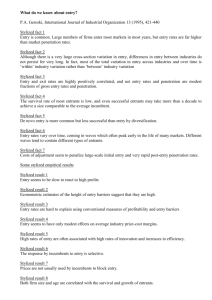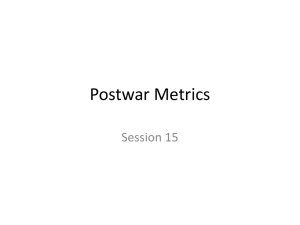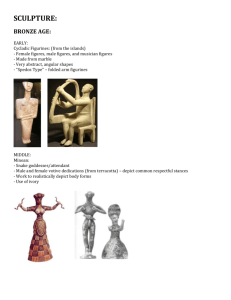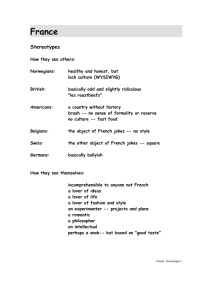Civilizations as Dynamic Networks
advertisement
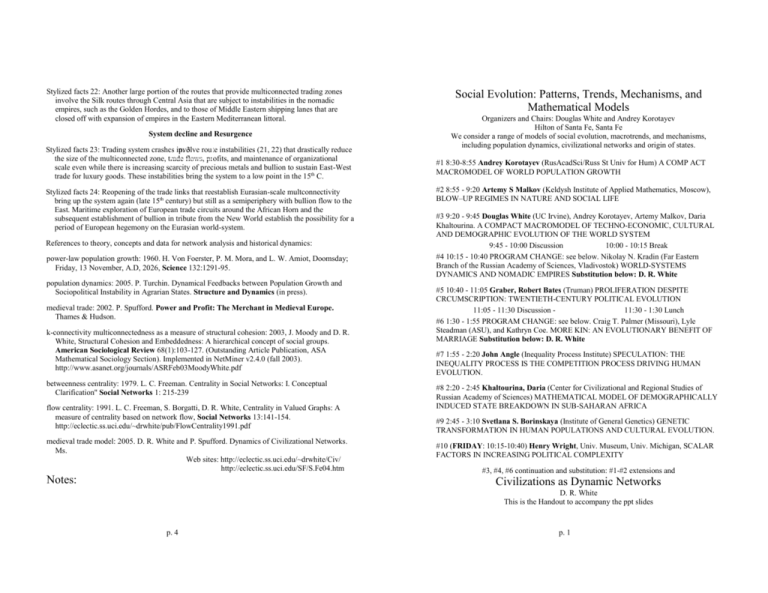
Stylized facts 22: Another large portion of the routes that provide multiconnected trading zones involve the Silk routes through Central Asia that are subject to instabilities in the nomadic empires, such as the Golden Hordes, and to those of Middle Eastern shipping lanes that are closed off with expansion of empires in the Eastern Mediterranean littoral. System decline and Resurgence Stylized facts 23: Trading system crashes involve p. 3 route instabilities (21, 22) that drastically reduce the size of the multiconnected zone, trade flows, profits, and maintenance of organizational scale even while there is increasing scarcity of precious metals and bullion to sustain East-West trade for luxury goods. These instabilities bring the system to a low point in the 15th C. Stylized facts 24: Reopening of the trade links that reestablish Eurasian-scale multconnectivity bring up the system again (late 15th century) but still as a semiperiphery with bullion flow to the East. Maritime exploration of European trade circuits around the African Horn and the subsequent establishment of bullion in tribute from the New World establish the possibility for a period of European hegemony on the Eurasian world-system. References to theory, concepts and data for network analysis and historical dynamics: power-law population growth: 1960. H. Von Foerster, P. M. Mora, and L. W. Amiot, Doomsday; Friday, 13 November, A.D, 2026, Science 132:1291-95. population dynamics: 2005. P. Turchin. Dynamical Feedbacks between Population Growth and Sociopolitical Instability in Agrarian States. Structure and Dynamics (in press). medieval trade: 2002. P. Spufford. Power and Profit: The Merchant in Medieval Europe. Thames & Hudson. k-connectivity multiconnectedness as a measure of structural cohesion: 2003, J. Moody and D. R. White, Structural Cohesion and Embeddedness: A hierarchical concept of social groups. American Sociological Review 68(1):103-127. (Outstanding Article Publication, ASA Mathematical Sociology Section). Implemented in NetMiner v2.4.0 (fall 2003). http://www.asanet.org/journals/ASRFeb03MoodyWhite.pdf betweenness centrality: 1979. L. C. Freeman. Centrality in Social Networks: I. Conceptual Clarification'' Social Networks 1: 215-239 flow centrality: 1991. L. C. Freeman, S. Borgatti, D. R. White, Centrality in Valued Graphs: A measure of centrality based on network flow, Social Networks 13:141-154. http://eclectic.ss.uci.edu/~drwhite/pub/FlowCentrality1991.pdf medieval trade model: 2005. D. R. White and P. Spufford. Dynamics of Civilizational Networks. Ms. Web sites: http://eclectic.ss.uci.edu/~drwhite/Civ/ http://eclectic.ss.uci.edu/SF/S.Fe04.htm Notes: Social Evolution: Patterns, Trends, Mechanisms, and Mathematical Models Organizers and Chairs: Douglas White and Andrey Korotayev Hilton of Santa Fe, Santa Fe We consider a range of models of social evolution, macrotrends, and mechanisms, including population dynamics, civilizational networks and origin of states. #1 8:30-8:55 Andrey Korotayev (RusAcadSci/Russ St Univ for Hum) A COMP ACT MACROMODEL OF WORLD POPULATION GROWTH #2 8:55 - 9:20 Artemy S Malkov (Keldysh Institute of Applied Mathematics, Moscow), BLOW–UP REGIMES IN NATURE AND SOCIAL LIFE #3 9:20 - 9:45 Douglas White (UC Irvine), Andrey Korotayev, Artemy Malkov, Daria Khaltourina. A COMPACT MACROMODEL OF TECHNO-ECONOMIC, CULTURAL AND DEMOGRAPHIC EVOLUTION OF THE WORLD SYSTEM 9:45 - 10:00 Discussion 10:00 - 10:15 Break #4 10:15 - 10:40 PROGRAM CHANGE: see below. Nikolay N. Kradin (Far Eastern Branch of the Russian Academy of Sciences, Vladivostok) WORLD-SYSTEMS DYNAMICS AND NOMADIC EMPIRES Substitution below: D. R. White #5 10:40 - 11:05 Graber, Robert Bates (Truman) PROLIFERATION DESPITE CRCUMSCRIPTION: TWENTIETH-CENTURY POLITICAL EVOLUTION 11:05 - 11:30 Discussion 11:30 - 1:30 Lunch #6 1:30 - 1:55 PROGRAM CHANGE: see below. Craig T. Palmer (Missouri), Lyle Steadman (ASU), and Kathryn Coe. MORE KIN: AN EVOLUTIONARY BENEFIT OF MARRIAGE Substitution below: D. R. White #7 1:55 - 2:20 John Angle (Inequality Process Institute) SPECULATION: THE INEQUALITY PROCESS IS THE COMPETITION PROCESS DRIVING HUMAN EVOLUTION. #8 2:20 - 2:45 Khaltourina, Daria (Center for Civilizational and Regional Studies of Russian Academy of Sciences) MATHEMATICAL MODEL OF DEMOGRAPHICALLY INDUCED STATE BREAKDOWN IN SUB-SAHARAN AFRICA #9 2:45 - 3:10 Svetlana S. Borinskaya (Institute of General Genetics) GENETIC TRANSFORMATION IN HUMAN POPULATIONS AND CULTURAL EVOLUTION. #10 (FRIDAY: 10:15-10:40) Henry Wright, Univ. Museum, Univ. Michigan, SCALAR FACTORS IN INCREASING POLITICAL COMPLEXITY #3, #4, #6 continuation and substitution: #1-#2 extensions and Civilizations as Dynamic Networks D. R. White This is the Handout to accompany the ppt slides p. 4 p. 1 Civilizations as Dynamic Networks Stylized facts 1: The general Eurasian population trend from 200 BCE – 1960 follows an inverse power-law growth curve Ň ≈ No/tα where t is time to singularity (estimated at ˜ 2030 CE) of a finite-time population limit of power-law growth (von Foerster et al. 1960). Stylized facts 2: Detrending actual population changes dN/dt = N - No/tα (hyperbolic growth when α = 1) yields autocorrelated deviations due to population conservations, giving popcycle lengths proportional to popcycle c log of starting date tc, measured in time to singularity, Lc ≈ log (tc). Stylized facts 3: Maximal upward popcycle periods produce resource competition and increased sociopolitical violence; sp violence lags popcycle by ¼ cycle with dynamic interaction leading popcycle by ¾ cycle with recurrent phases (Turchin 2005). This is the popwar dynamic. The Commercial Revolution of the 13th Century Circum-European Region (1175-1500) Stylized facts 4: With greater scarcity of resources, land and feudal estates (also a source of protection) become more valuable, leading to rural area land value inflation (Spufford 2002). Stylized facts 5: Inflation of land value is an incentive for rural lords to find better returns than the tithes of vassals with rights to land use. Owners forcing peasants off the land substitute rentals of land for money. Renters sell products for money to merchants. Migration of displaced peasants to cities where merchants foster industries with rural, craft and other products, apprenticed and wage labor and resultant urban agglomeration (Spufford 2002). Stylized facts 6: With money rents lords can pay retainers to run their estates and nobility can move to cities, adding to the urbanization spiral a monetization spiral but to the increasing elite demand for luxury goods in exchange for monetary wealth and credit (Spufford 2002). Stylized facts 7: Luxury goods include a rising demand for those not available locally, and the world-system cores of this period, China and India, are the source of growing luxury imports in return for European bullion. In addition to importing bullion from the African Gold Coast through merchant caravans, search for rare metals and mining increase dramatically, along with minting of coins (Spufford 2002). Stylized facts 8: Multiconnected trading zones among cities foster market mechanisms, price stability and market equilibrium that can flourish only with competition between different supply-demand routes for each pair of cities in the zone. Because single-route peripheries allow monopolies and price fixing, inflationary tendencies are amplified in non-core zones (e.g., rural areas, and cities whose supply routes from other cities are single-path). With greater market demand through routes to China and India, the multiplicity of routes to/from those areas increases, creating multiconnected zones nearly an order of magnitude larger. Stylized facts 9: Cities in the multiconnected zone prosper disproportionally. With much larger multiconnected zones there is much more innovation, both through diffusion and through inventive recombination occurring in urban areas. Cities in the multiconnected zone benefit disproportionally. Stylized facts 10: Cities in the multiconnected zone are exposed disproportionally to epidemic diseases and consequent population instabilities. p. 2 Stylized facts 11: Cities with high betweenness centrality are at a competitive advantage in their local area (since betweenness is based on mediating shortest paths between nearby nodes) and prosper disproportionally in a mercantile economy (White and Spufford 2005). Stylized facts 12: Cities with high flow centrality are at a competitive advantage in the global trade network (since their proportion of total flow is measured by the effect of their removal on total network flow) and prosper disproportionally in a profit-oriented economy. Stylized facts 13: Rising velocities of trade, measured overall as the ratio of total shipping value over the total GDP producing the goods shipped, is variable as it affects local organizations (cities, merchants, churches, estates, bureaucracies). Major organizational transformations are observed to occur when the organizational velocity of trade (i.e., network flows through the organization) surpasses the current capacity of the organization (White and Spufford 2005). Stylized facts 14: Cities and other organizations with high flow centrality, when these flows reach critical capacity thresholds, are among those that undergo organizational transformations (White and Spufford 2005). Stylized facts 15: Specialized agents that emerge as organizational transformations and innovations (13, 14) alter the agent space (Spufford 2002, White and Spufford 2005) and relocate according to cost-benefit interactions in the agent space. Stylized facts 16: Organizations that have the accumulated capital to invest in transportation routes will tend to make those investments when they will derive proportionally greater benefits from increased transport flow (e.g., mercantile, church benefits, military or police control by quicker movements of personnel - Spufford 2002, White and Spufford 2005). Stylized facts 17: Industries will tend to locate in sites with a high ratio of transport flow (or local flow potential because of high betweenness centrality) to production (or organizational complexity - White and Spufford 2005). Stylized facts 18: Similarly for location of trade fairs in areas where urban markets and populations are lacking. Stylized facts 19: Co-evolution of industries and routes follow a complex multidimensional intersection hierarchy with competitive/collaborative economic dynamic still to be determined. Stylized facts 20: A large portion of the routes that co-construct multiconnected trading zones involves maritime shipping lanes as alternatives to land routes. These become vulnerable to piracy, and piracy creates incentives for faster boats that travel further from shore, which provides, a secondary dynamic within the popwar dynamic. Stylized facts 21: Because of the vulnerability in sea routes, the courier routes for credit transitions in the banking system are land-based wherever possible. Efficiency in this system requires largely 1-connected or tree-like links with cutpoints. The particular structure of this system has a single cutnode that separates four large branches, and is controlled by Milan, which is the land-based power-broker of the Medieval credit and trading system. Other potential centers such as Florence compete within the same region.
